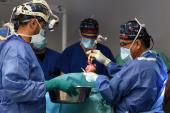Innovation in Heart Donation, Preservation Set to Shake Up Allocation
Efforts are needed to ensure that innovations in heart transplantation are available to all, Maryjane Farr says.

As heart transplantation involving donation after circulatory death (DCD) becomes more common in the United States, expanding the potential donor pool, it’s leading to questions about how organ allocation policies might have to change to ensure that this innovation is being made available equitably across the country.
Growth in DCD transplants, helped along by new methods for organ preservation and recovery, comes at a time when experts working with the Organ Procurement & Transplantation Network (OPTN) are developing new continuous distribution policies for donor hearts and other organs. The idea is that both fairness and equity in allocation will be enhanced through consideration of multiple different factors that influence mortality risk when matching donors and recipients.
“As we consider future changes to heart allocation policy, including continuous distribution and a heart allocation score, which is more like a lung allocation score, we need to decide how and whether to factor in each recipient’s access to these novel preservation and recovery strategies,” Maryjane Farr, MD (UT Southwestern Medical Center, Dallas, TX), told TCTMD, adding, “I don’t know that policy can take care of every last access issue.”
Farr, along with Lauren Truby, MD (UT Southwestern Medical Center), and Prateeti Khazanie, MD (University of Colorado School of Medicine, Aurora), outlined some of the changes coming to the heart allocation system, and how DCD transplants are expected to influence them, in a commentary in JACC: Heart Failure. Farr and Khazanie also discussed some of these issues during a session at the recent Heart Failure Society of America (HFSA) 2023 meeting.
Back in 2018, the United Network for Organ Sharing (UNOS) and the OPTN made changes to policies around donor heart allocation aimed at reducing waitlist mortality, and recent data show that that goal was accomplished while making patients more likely to undergo transplantation, Farr said.
Importantly, however, these data largely don’t reflect the impact of DCD transplants facilitated by preservation methods like the TransMedics Organ Care System, normothermic regional perfusion (NRP), and others. Since the first DCD transplant was performed in late 2019, there have been more than 1,000 completed in the US as of last month.
“It’s new enough that we haven't analyzed the impact of DCD transplant into allocation policy, and that is important because allocation will change soon,” Farr said.
DCD transplants differ from conventional heart transplants involving donation after brain death (DBD), Farr highlighted, with one key difference being that an individual is declared dead before consent for organ donation in the latter case and while the individual is still alive—and considered a patient, not a donor, at that point—in the case of DCD transplants. Thus, there are unique issues involving ethics, the type of testing and therapies that can be used before transplantation, and where hearts can be recovered in DCD cases. Center-specific policies around use of DCD hearts can vary widely, too.
Farr highlighted several open questions that are relevant to discussions about how much innovations in heart transplantation, including DCD transplants, should influence future policy. Those revolve around whether there should be something akin to the kidney donor profile index for renal transplantation when it comes to assessing the risk profile for a donor heart and how much donor and recipient factors impact outcomes.
“If we’re going to change policy to include outcomes or survival after transplant, do we need to account for the way in which we transplant a patient? And then there’s sort of an ethical question of: should patients who need transplant have opportunity for all the possible modalities?” Farr said.
Where the field is going, she said, is toward a continuous distribution allocation system whereby each candidate will have a score calculated based on multiple variables, including expected waitlist survival, blood type, sensitization, proximity to a transplant center, expected time of life after a transplant, and candidate size. That system is expected to be rolled out in a year or so, she added.
Recent studies have demonstrated the impact that DCD heart transplantation can have. A randomized trial, for instance, showed that recipients of DCD hearts had survival similar to that of DBD hearts. An earlier observational study also showed similar outcomes with DCD and DBD transplants, demonstrating, too, that DCD hearts tended to go less-sick patients living at home. “DCD has been enormously helpful in terms of unloading a heavy waitlist and leaving the really high-risk statuses . . . for standard DBD,” Farr said, adding, however, that more-recent data indicate that DCD is being increasingly used for higher-risk patients, too.
Overall, DCD transplantation is expected to increase US heart transplant volumes by about 30%, according to a review published earlier this year by Farr’s team, with centers offering the service expected to have shorter waitlist times, reduced waitlist mortality, and higher overall transplant volumes.
Moving forward, equity remains an important goal, Farr indicated. “Every effort should be made to expand innovation and transplant opportunity to all potential recipients, irrespective of transplant center location,” she said, noting that factors like patient preference and cost will be involved.
Todd Neale is the Associate News Editor for TCTMD and a Senior Medical Journalist. He got his start in journalism at …
Read Full BioSources
Truby L, Khazanie P, Farr M. Addressing United States heart transplant allocation in an era of rapid innovation. J Am Coll Cardiol HF. 2023;Epub ahead of print.
Disclosures
- Truby reports having received funding from the American Heart Association and the UT Southwestern Presidential Research Council.
- Khazanie reports having received research funding from the National Institutes of Health (NIH)/National Heart, Lung, and Blood Institute, an NIH Ethics Grant, the University of Colorado Ludeman Center for Women’s Health Research, and the Doris Duke Fund to Retain Clinical Researchers.
- Farr reports being a member of the steering committee for TransMedics and of the UNOS/OPTN board of directors.





Comments